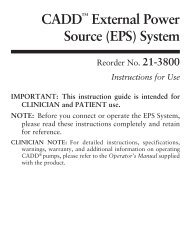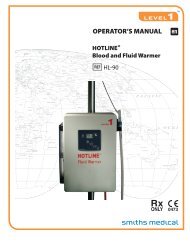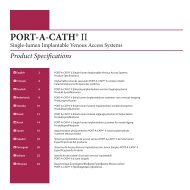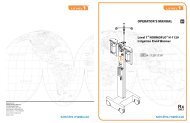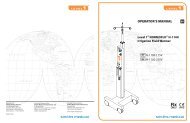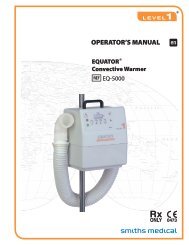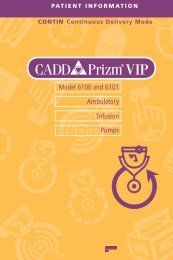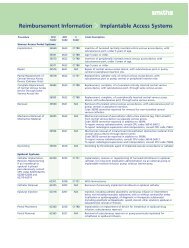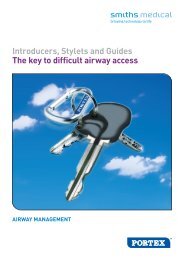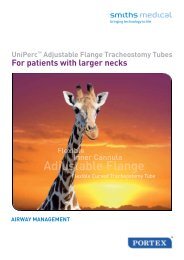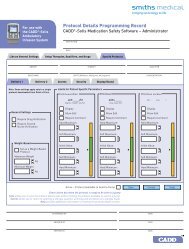40-5091-24B IFU PAC-PACII.indd - Smiths Medical
40-5091-24B IFU PAC-PACII.indd - Smiths Medical
40-5091-24B IFU PAC-PACII.indd - Smiths Medical
Create successful ePaper yourself
Turn your PDF publications into a flip-book with our unique Google optimized e-Paper software.
10. Using a second 10-ml or larger syringe, fl ush the system with 10-ml of normal<br />
saline, taking care not to apply excessive force to the syringe. Diffi culty in injecting<br />
or infusing fl uid may indicate catheter blockage.<br />
During this saline fl ush, observe the portal pocket and catheter tract for swelling<br />
and inquire or observe whether the patient is experiencing burning, pain, or<br />
discomfort at the portal site. If any of these symptoms are noted and/or swelling<br />
of the portal pocket and catheter tract is observed, fl uid extravasation into the<br />
portal pocket or catheter tract should be suspected.<br />
NOTE: If the system is dual-lumen, repeat steps 1 through 10 for the other<br />
portal chamber.<br />
A.1 System Integrity is Verifi ed – Portal Will<br />
Not Be Used Immediately<br />
1. Attach a 10-ml or larger syringe fi lled with 5 ml of heparin solution (10 to 100<br />
IU/ml).<br />
2. Establish a heparin lock by instilling 5 ml of heparin solution (10 to 100 IU/ml).<br />
To maintain positive pressure, clamp the extension set tubing while injecting the<br />
last 0.5 ml of heparin solution.<br />
3. Withdraw the non-coring needle.<br />
NOTE: If using a straight, non-coring needle, stabilize the portal and withdraw<br />
the syringe and non-coring needle while injecting the last 0.5 ml.<br />
4. Discard the needles and syringes according to established protocol.<br />
A.2 System Integrity Is Verifi ed – Injection Or<br />
Infusion Will Be Initiated Immediately<br />
1. Secure the non-coring needle according to established protocol. Replace the<br />
syringe with an injection cap, IV tubing, or needleless access device.<br />
2. Clean the injection cap or extension set hub according to established protocol.<br />
3. Connect the fl uid delivery system according to established protocol.<br />
NOTE: Follow the Centers for Disease Control and Prevention (CDC) guidelines<br />
or established hospital/institutional policy for changing tubing.<br />
4. Secure all connections.<br />
5. Begin the infusion or give the injection.<br />
WARNING: To avoid a possible drug precipitation and resulting catheter occlusion,<br />
thoroughly fl ush the system with an appropriate solution before and after each<br />
injection or infusion when administering medications that may be incompatible with<br />
one another. Refer to the manufacturer’s specifi c instructions and labeling for each<br />
medication before administration.<br />
6. Upon completion of the infusion or injection, fl ush the system with 10 ml of<br />
normal saline using a 10 ml or larger syringe and do one of the following:<br />
• Give another injection or begin the next infusion.<br />
• Establish a heparin lock by instilling 5 ml of heparin solution (10 to 100 IU/ml).<br />
To maintain positive pressure, clamp the extension set tubing while injecting the<br />
last 0.5 ml of heparin solution.<br />
NOTE: If using a straight, non-coring needle, stabilize the portal and withdraw<br />
the syringe and non-coring needle while injecting the last 0.5 ml.<br />
7. Discard the needles and syringes according to established protocol.<br />
B. Flushing Schedule<br />
System integrity must be verifi ed before fl ushing the portal (refer to Determining<br />
System Integrity).<br />
For venous systems, maintain system patency by fl ushing it with heparin solution at<br />
least once every four weeks when not in use.<br />
For arterial systems, maintain system patency by fl ushing it with heparin solution at<br />
least once every week when not in use.<br />
NOTE: The self-sealing septum of a PORT-A-CATH® vascular portal allows up to<br />
2000 punctures (1500 punctures for Low Profi le ports) with a 22 gauge (0.7 mm)<br />
PORT-A-CATH® access needle.<br />
C. Blood Sampling Procedure<br />
(Venous Systems Only)<br />
System integrity must be verifi ed before doing a blood sampling procedure (refer to<br />
Determining System Integrity).<br />
NOTE: It is recommended that a 10-ml or larger syringe be used for injecting or<br />
infusing fl uids through the system.<br />
1. Flush the system using a non-coring PORT-A-CATH® access needle with 10 ml<br />
of normal saline to verify that the system is not occluded.<br />
2. Slowly withdraw at least 5 ml of blood and dis card.<br />
3. Withdraw the volume of blood required.<br />
4. Immediately inject 20 ml of nor mal saline.<br />
5. Establish a heparin lock by instilling 5 ml of heparin solution (10 to 100 IU/ml).<br />
Maintain positive pressure by withdrawing the syringe while injecting the last 0.5<br />
ml of heparin solution.<br />
6. Discard the needles and syringes according to established protocol.<br />
D. Discontinuing System Use<br />
If it is determined that the system is no longer required for therapy, the clinician<br />
should consider explantation of the system. If the system is left in place, then periodic<br />
x-ray with the patient in an upright, arms-at-sides position is recommended to<br />
detect problems with the system, such as pinching of the catheter between the<br />
clavicle and fi rst rib which could result in catheter fragmentation and subsequent<br />
embolization. 1,4,5,8<br />
E. References<br />
1. Klotz HP, Schopke W, Kohler A, Pestalozzi B, Largiader F. Catheter Fracture: A Rare Complication<br />
of Totally Implantable Subclavian Venous Access Devices. J Surgical Oncol 1996; 62:222.<br />
2. Vadlamani P, Dawn B, Perry MC. Catheter Fracture and Embolization from Totally Implanted<br />
Venous Access Ports. J Vascular Dis 1998; 12:1013.<br />
3. Monsuez JJ, Douard MC, Martin-Bouyer Y. Catheter Fragments Embolization. J Vascular Dis<br />
1997;2:117.<br />
4. Ramsden WH, Cohen AT, Blanshard KS. Case Report: Central Venous Catheter Fracture Due to<br />
Compression Between the Clavicle and First Rib. Clinical Radiology 1995;50:59.<br />
5. Coles CE, Whitear WP, Le Vay JH. Spontaneous Fracture and Embolization of a Central Venous<br />
Catheter: Prevention and Early Detection. Clinical Oncology 1998;10:412.<br />
6. Kossoff EH, Poirier MP. Peripherally inserted central venous catheter fracture and embolization<br />
to the lung. Pediatric Emer Care 1998;6:<strong>40</strong>3.<br />
7. Lafreniere R. Indwelling Subclavian Catheters and a Visit With the “Pinched-Off Sign”. J Surgical<br />
Oncol 1991;47:261.<br />
8. Hinke DH, Zandt-Stastny DA, Goodman LR, Quebbeman EJ, Krzywda EA, Andris DA. Pinch-off<br />
Syndrome: A Complication of Implantable Subclavian Venous Access Devices. Radiology<br />
1990;177:353<br />
9. Franey T, Demarco LC, Geiss AC, Ward RJ. Catheter fracture and embolization in a totally<br />
implanted venous access catheter. J Parent Ent Nutr 1988;12:528<br />
10. Moureau NL, McKinnon BT, Douglas CM. Multidisciplinary management of thrombotic<br />
catheter occlusions. J Vasc Acces Dev<br />
1999; summer:22<br />
9



